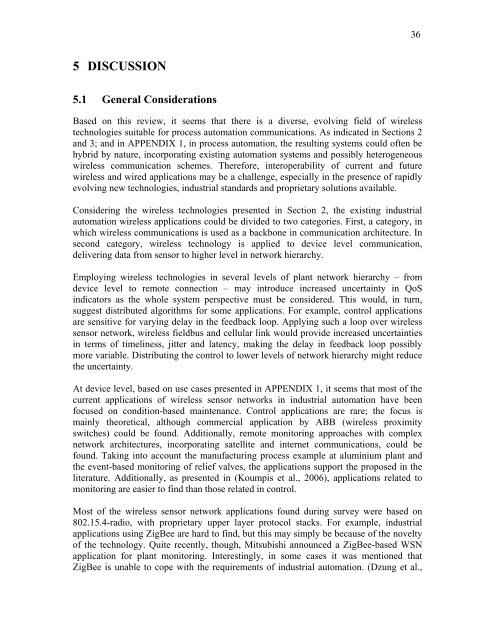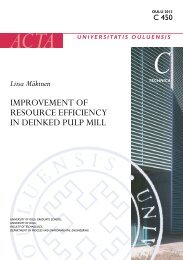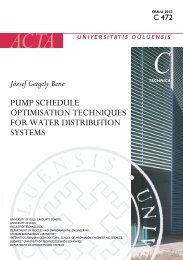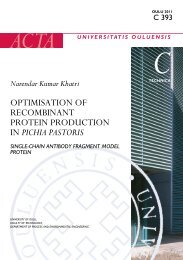Wireless Technologies in Process Automation - Herkules.oulu.fi - Oulu
Wireless Technologies in Process Automation - Herkules.oulu.fi - Oulu
Wireless Technologies in Process Automation - Herkules.oulu.fi - Oulu
Create successful ePaper yourself
Turn your PDF publications into a flip-book with our unique Google optimized e-Paper software.
36<br />
5 DISCUSSION<br />
5.1 General Considerations<br />
Based on this review, it seems that there is a diverse, evolv<strong>in</strong>g <strong>fi</strong>eld of wireless<br />
technologies suitable for process automation communications. As <strong>in</strong>dicated <strong>in</strong> Sections 2<br />
and 3; and <strong>in</strong> APPENDIX 1, <strong>in</strong> process automation, the result<strong>in</strong>g systems could often be<br />
hybrid by nature, <strong>in</strong>corporat<strong>in</strong>g exist<strong>in</strong>g automation systems and possibly heterogeneous<br />
wireless communication schemes. Therefore, <strong>in</strong>teroperability of current and future<br />
wireless and wired applications may be a challenge, especially <strong>in</strong> the presence of rapidly<br />
evolv<strong>in</strong>g new technologies, <strong>in</strong>dustrial standards and proprietary solutions available.<br />
Consider<strong>in</strong>g the wireless technologies presented <strong>in</strong> Section 2, the exist<strong>in</strong>g <strong>in</strong>dustrial<br />
automation wireless applications could be divided to two categories. First, a category, <strong>in</strong><br />
which wireless communications is used as a backbone <strong>in</strong> communication architecture. In<br />
second category, wireless technology is applied to device level communication,<br />
deliver<strong>in</strong>g data from sensor to higher level <strong>in</strong> network hierarchy.<br />
Employ<strong>in</strong>g wireless technologies <strong>in</strong> several levels of plant network hierarchy – from<br />
device level to remote connection – may <strong>in</strong>troduce <strong>in</strong>creased uncerta<strong>in</strong>ty <strong>in</strong> QoS<br />
<strong>in</strong>dicators as the whole system perspective must be considered. This would, <strong>in</strong> turn,<br />
suggest distributed algorithms for some applications. For example, control applications<br />
are sensitive for vary<strong>in</strong>g delay <strong>in</strong> the feedback loop. Apply<strong>in</strong>g such a loop over wireless<br />
sensor network, wireless <strong>fi</strong>eldbus and cellular l<strong>in</strong>k would provide <strong>in</strong>creased uncerta<strong>in</strong>ties<br />
<strong>in</strong> terms of timel<strong>in</strong>ess, jitter and latency, mak<strong>in</strong>g the delay <strong>in</strong> feedback loop possibly<br />
more variable. Distribut<strong>in</strong>g the control to lower levels of network hierarchy might reduce<br />
the uncerta<strong>in</strong>ty.<br />
At device level, based on use cases presented <strong>in</strong> APPENDIX 1, it seems that most of the<br />
current applications of wireless sensor networks <strong>in</strong> <strong>in</strong>dustrial automation have been<br />
focused on condition-based ma<strong>in</strong>tenance. Control applications are rare; the focus is<br />
ma<strong>in</strong>ly theoretical, although commercial application by ABB (wireless proximity<br />
switches) could be found. Additionally, remote monitor<strong>in</strong>g approaches with complex<br />
network architectures, <strong>in</strong>corporat<strong>in</strong>g satellite and <strong>in</strong>ternet communications, could be<br />
found. Tak<strong>in</strong>g <strong>in</strong>to account the manufactur<strong>in</strong>g process example at alum<strong>in</strong>ium plant and<br />
the event-based monitor<strong>in</strong>g of relief valves, the applications support the proposed <strong>in</strong> the<br />
literature. Additionally, as presented <strong>in</strong> (Koumpis et al., 2006), applications related to<br />
monitor<strong>in</strong>g are easier to f<strong>in</strong>d than those related <strong>in</strong> control.<br />
Most of the wireless sensor network applications found dur<strong>in</strong>g survey were based on<br />
802.15.4-radio, with proprietary upper layer protocol stacks. For example, <strong>in</strong>dustrial<br />
applications us<strong>in</strong>g ZigBee are hard to f<strong>in</strong>d, but this may simply be because of the novelty<br />
of the technology. Quite recently, though, Mitsubishi announced a ZigBee-based WSN<br />
application for plant monitor<strong>in</strong>g. Interest<strong>in</strong>gly, <strong>in</strong> some cases it was mentioned that<br />
ZigBee is unable to cope with the requirements of <strong>in</strong>dustrial automation. (Dzung et al.,
















